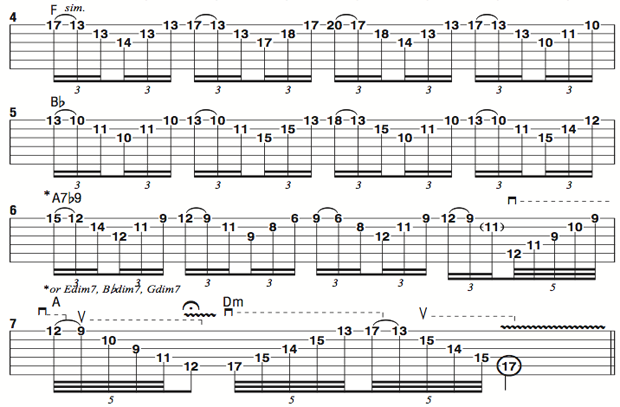Time to Burn with Michael Angelo Batio: Applying Sweep Picking to Chord Progressions, Part 2
Last month, I introduced the concept of applying different sweep-picked arpeggio shapes to a series of chords within a repeating progression.
This month, I’d like to expand our view to a greater variety of sweep-picked shapes, as well as a more complex, ambitious chord progression.
To quickly review, a sweep—also often referred to as a rake—is the term used to describe dragging the pick across a series of adjacent strings in a single stroke, either a downstroke or an upstroke. Ascending melodies are played with downstroke sweeps and descending melodies are played with upstroke sweeps.
Sweep picking is the most effective guitar technique for replicating the fast arpeggio-based lines often heard in classical piano and violin music. Johann Sebastian Bach, for example, composed a suite of musical etudes (exercises) for violinists called the Sonatas and Partitas for Solo Violin, many of which feature long passages of arpeggios that melodically outline a chord progression using only single notes, with no accompaniment.
A common progression heard in these pieces is one that moves through the cycle of fourths.
FIGURE 1 offers a seven-bar exercise that does this in the key of D minor: starting on Dm, the progression moves up a fourth to Gm, followed by C, F, and Bb, each arpeggio being rooted a fourth above (or a fifth below) the previous chord. In bar 6, I move from Bb down to A7b9 as a means to set up a V-i (five to one-minor) resolution back to Dm. This A7b9 chord may also be analyzed as Edim7, Gdim7, Bbdim7 or C#dim7, superimposed over an A root note. Once I resolve the diminished-type sound of A7b9 to A major, I then resolve back to Dm.
For virtually every chord in the progression, a sweep arpeggio based on a steady rhythm of 16th-note triplets is employed, with an upbeat “pickup” used on the preceding eighth-note upbeat, so that the highest note of each arpeggio shape falls on the downbeat of beat one or three. Additionally, for each chord, the initial arpeggio shape is played across two beats, followed by a shift to the next higher arpeggio shape, or inversion, for one beat, followed by a return to the previous lower-voiced arpeggio shape.
Get The Pick Newsletter
All the latest guitar news, interviews, lessons, reviews, deals and more, direct to your inbox!
Be sure to follow the pick stroke indications above the tablature, and strive to articulate each note clearly and distinctly. Use fret-hand muting to quickly silence the previous notes you’ve just played so that they don’t ring, or “bleed,” together, which takes away from the melodic sweep effect and makes it sound like you’re just strumming a chord shape.
At the very end of bar 5 and into bar 6, I sequence through three different inversions and positions of a diminished-seven shape across the top three strings, starting in 12th position and then quickly shifting down down in minor-third (three-fret) intervals twice, to ninth and sixth positions. At the end of bar 6 and into bar 7, I switch to a larger A major arpeggio shape that spans the top five strings in a faster quintuplet rhythm before finally resolving to Dm on beat two of bar 7. Be sure to play through this long sequence slowly and deliberately before ramping up the tempo.












